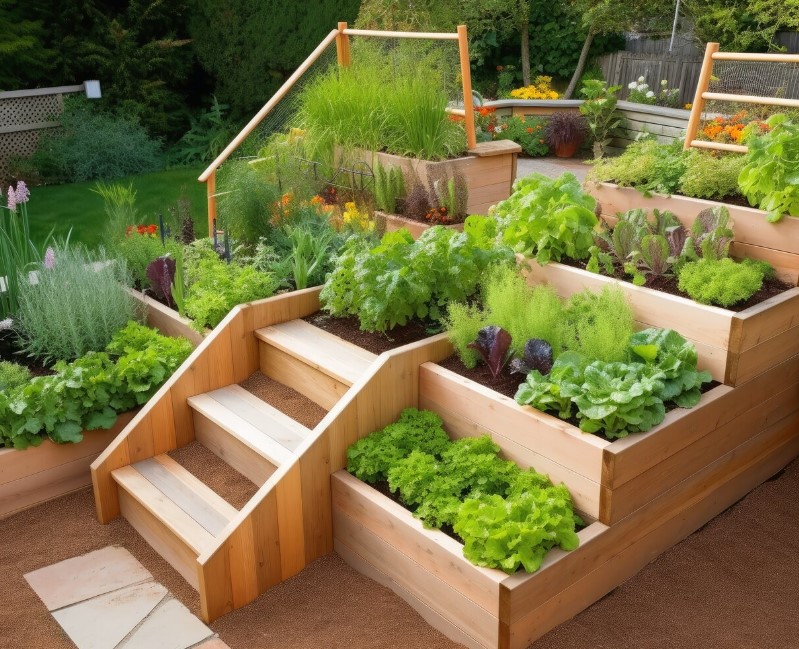In gardening, raised beds have emerged as a symbol of efficiency, productivity, and sustainability. Their popularity continues to soar, appealing to novice and seasoned gardeners alike, owing to their myriad benefits. These benefits encompass everything from improved soil quality to superior water drainage, making raised bed gardening a favored choice for many. Let’s explore raised bed gardening in-depth, examining its advantages, construction methods, suitable plants, and maintenance tips.
Understanding Raised Bed Gardening
Raised bed gardening entails cultivating plants in beds elevated above ground level, typically enclosed within frames crafted from various materials such as wood, stone, metal, or composites. The height of these beds varies but commonly ranges from 6 to 12 inches, though some may exceed this.
Advantages of Raised Bed Gardening
The appeal of raised bed gardening lies in its multitude of advantages:
- Improved Soil Quality: Raised beds permit gardeners to fill them with high-quality soil, creating optimal conditions for plant growth. This proves especially beneficial in areas plagued by poor soil quality or contamination.
- Enhanced Drainage: Raised beds facilitate better drainage, mitigating issues like waterlogging and soil compaction, which can impede root development.
- Warmer Soil: The elevated nature of raised beds expedites soil warming in spring, enabling earlier planting and prolonged growing seasons.
- Accessibility: The raised height of beds makes gardening more accessible, particularly for individuals with mobility constraints or those averse to bending over.
- Weed Control: Raised beds offer easier weed management, as they are less susceptible to encroachment from surrounding areas.
- Pest Management: Raised beds can deter certain pests, such as slugs and snails, as well as larger animals, such as rabbits and groundhogs.
- Aesthetic Appeal: In addition to their practical benefits, raised beds enhance a garden’s visual allure by imparting structure and organization to the landscape.
Constructing Raised Beds
Creating raised beds is a relatively straightforward process, customizable to individual preferences and garden layouts:
- Choose a Location: Opt for a sunny spot with good drainage, ensuring easy access for watering and maintenance.
- Select Materials: Decide on materials for bed frames, avoiding treated lumber containing harmful chemicals. Options include cedar, concrete blocks, and composite materials.
- Determine Size and Shape: Choose the dimensions and shape based on available space and aesthetic preferences, with rectangular or square beds being popular choices.
- Prepare the Ground: Clear vegetation, level the ground if needed, and lay down weed barrier fabric to prevent weed growth from below.
- Construct the Frame: Assemble a sturdy, level frame using chosen materials, securing corners for stability.
- Fill with Soil: Fill beds with a mixture of topsoil, compost, and other amendments to create a nutrient-rich growing medium.
- Optional Additions: Consider installing irrigation systems, trellises, or covers for added functionality.
Choosing Plants for Raised Beds
Raised bed gardening allows for diverse plant selections in a compact space:
- Vegetables: Tomatoes, peppers, lettuce, spinach, kale, carrots, and radishes thrive in raised beds and yield abundant harvests.
- Herbs: Basil, cilantro, parsley, thyme, and rosemary flourish in raised bed herb gardens, enriching culinary endeavors.
- Fruits: Strawberries, raspberries, and dwarf fruit trees can be grown in raised beds, providing sweet harvest additions.
- Flowers: Marigolds, zinnias, cosmos, and sunflowers add color and allure while attracting beneficial pollinators.
- Perennials: Lavender, sage, and sedum are among the many perennials that thrive in raised beds, offering year-round interest.
Maintaining Raised Bed Gardens
Regular maintenance is crucial for the long-term success of raised bed gardens:
- Watering: Monitor soil moisture and water as needed, ensuring consistent levels, especially during hot and dry spells.
- Weeding: Keep beds weed-free by hand-pulling or using mulch to suppress growth.
- Fertilizing: Replenish soil nutrients with compost or organic fertilizers throughout the growing season.
- Pruning and Harvesting: Trim back plants and harvest ripe produce regularly to encourage continued growth.
- Pest and Disease Management: Monitor for pests and diseases, taking appropriate measures to prevent damage.
- Seasonal Maintenance: Clean out beds, remove spent plants, and amend soil to prepare for the next growing season.
Conclusion
Raised bed gardening presents many benefits for gardeners of all levels, fostering improved soil quality, accessibility, and productivity. Following the guidelines, you can establish and maintain a flourishing raised bed garden, yielding abundant harvests and endless enjoyment. Whether you’re a seasoned or a newcomer, raised bed gardening offers a gratifying journey, allowing you to unleash creativity and cultivate a sustainable oasis in your backyard.

